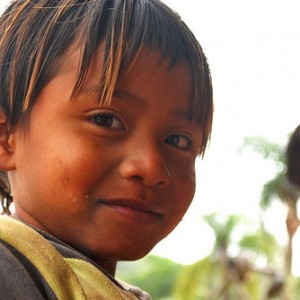Print  |
|


Guarani monolingual resistance in Paraguay
Posted by Christine Pic-Gillard on March 4, 2011
By Christine Pic-Gillard, Doctor in Hispanic studies (Paris 3), Professor at the University of La Réunion.

BY Ianpozzobon (cc)
Paraguay, a small country of some five million inhabitants, is completely landlocked in the South American continent, to the point of considering itself as an island. This isolation has been the source of an insular syndrome bearing fear of an outside threat. While the threat of an invasion by the large neighbouring countries has disappeared nowadays, the feeling for a need to defend identity and linguistic specificities remains. And this defence includes resisting Guarani/Spanish bilingualism, perceived as an attempt to weaken Guarani.
On the South American continent, where the languages of origin have often been swept away, and where the only official language is usually Spanish, the linguistic realities of Paraguay are indeed very peculiar: a 1992 census reveals a large majority of Guarani speakers (around 89%), a very limited number of Spanish monolinguals, a majority of Guarani monolinguals, and a number of Spanish/Guarani bilinguals of around 48%.
The year 1992 consequently saw the political shaping of a myth on which Paraguay had defined itself since the Spanish colonization, the myth of Guarani/Spanish hybridization: that year, the new democratic constitution declares Paraguay as a bilingual country. The Amerindian language of the majority thus becomes one of the two official languages, on equal terms with Spanish, and a Bilingual Education Plan (PEB) is imposed upon children attending school from 1994, regardless of their linguistic origins.
A actual linguistic revolution, therefore, totally silent yet carrying significant resources, is established in 1994: the PEB is meant to spread over twenty-five years, that is an entire generation meant to turn bilingual. While in other places such initiative might have been considered favourable to the speakers of indigenous languages, that was not the case in Paraguay, where Guarani used to have the upper hand and faced the risk of losing ground to compelled bilingualism. Here, the compulsory bilingual education project does in fact stand as a project aiming to reduce and eventually rule out monolingualism, the most important of which was that of Guarani.
Resistance is set in motion at the beginning of the 2000s: peasant organizations act as a relay for reclaiming Guarani as the only official language of Paraguay. They also challenge the European culture of productivism conveyed by the Spanish language, and claim a return to the Amerindian culture of Human harmony with nature embodied by “el modo de ser guarani” (the way of being Guarani).
The bilingual motto “¡sólo progresan los pueblos que leen!/ Toikove kuatiaeñë!” (The only peoples who progress are the peoples who read!) still lies high on the wall of a bookstore on the central square of Asunción. An exclamation that might be reversed into a question: are the peoples who progress really those who read? This remains the question raised by those involved in Guarani language demands and resistance to the Bilingual Education Plan. From where they stand, bilingualism and literacy are everything but factors for progress.








